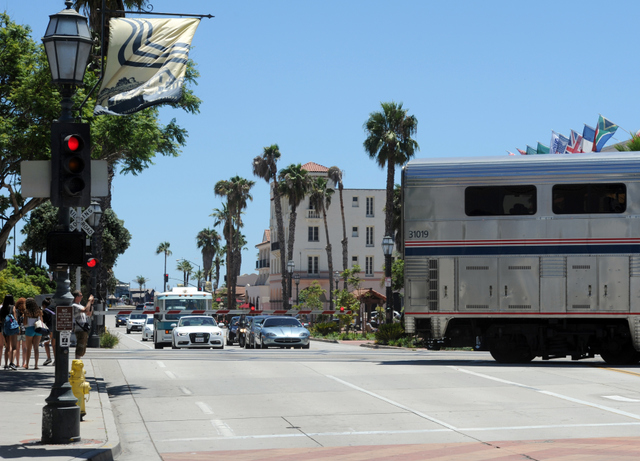La Entrada Hits Snag
Worries Emerge That Traffic May Back Up to Railroad Tracks

Efforts to begin construction on the La Entrada development — 123 new hotel rooms to be spread over three square blocks at the intersection of State and Mason streets — has hit a snag with the California Public Utilities Commission (CPUC), which has expressed concern that traffic on State Street might back up from the stoplight slated for that corner all the way up to the railroad tracks. The CPUC claims exclusive jurisdiction over all railroad tracks in the state.
At issue is the extent to which the lane squeeze and road diet imposed on the lower stretch of State Street in order to allow for the wider “boulevard” sidewalks will have the effect of causing traffic to back up and potentially block the railroad tracks. On May 28, Santa Barbara traffic engineer Derek Bailey submitted detailed plans to the CPUC showing how the problem could be averted by coordinating the signals at two intersections — State and Mason and State and Yanonali — to limit the backup of traffic. Bailey said this could be accomplished by giving the light at Mason a longer green sequence than the signal at Yanonali. (As a condition of approval, developer Michael Rosenfeld is required to install a new traffic signal at State and Mason because his hotel will command three of the intersection’s four corners.)
CPUC engineer Carlo Groag confirmed he got such plans from Bailey but said he hasn’t reviewed them sufficiently to render a conclusion. Groag said he will be meeting in Santa Barbara with Bailey and officials with Southern Pacific Railroad in August. Should those arrangements be deemed workable, Groag said City Hall would then have to submit formal plans, which they haven’t done yet. Groag would then have 45 days to decide.
The $64 million question is how this issue could emerge as a last-minute surprise for a project that was first approved by the City Council 13 years ago and has undergone six subsequent design changes and no less than three ownership changes. Over the years, many people have voiced concern about the road-narrowing aspects of the project design, but it’s always been part of the plan. This detail was inserted at the insistence of city traffic planners and elected officials, not the developers. One explanation is that former city attorney Steve Wiley — who retired only a few months ago — had long insisted that the CPUC had no jurisdiction over the project, but that his successor, Ariel Calonne, was adamant that it did.
The project — long a black hole of delay and inactivity — has generated much consternation and impatience among councilmembers, city officials, and business owners along lower State Street. In response, the latest owner — Rosenfeld — has been placed on a strict timeline by City Administrator Jim Armstrong. Compared to the previous two owners — Bill Levy and Mountain Funding — Rosenfeld has qualified as a veritable beehive of construction activity. He narrowed the southbound lane of State Street, expanded the sidewalk, and has spent $13 million on plans, drawings, and ushering the project through the city’s intricate design review process.
Of concern is the extent to which this delay could put Rosenfeld at odds with the construction deadlines he’s agreed to. Likewise, it’s not known how much it might impede Rosenfeld’s ability to secure the funding needed to build the ambitious upscale development. To date, Rosenfeld has hit all his project-specific deadlines with City Hall, while at the same time he bought and essentially rebuilt the interior of the Chapala One mixed-use development on lower Chapala Street.


